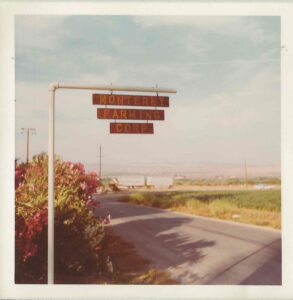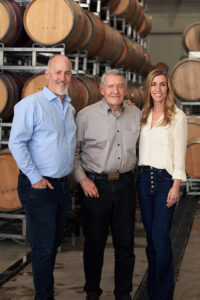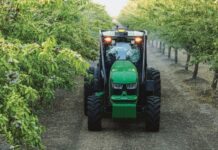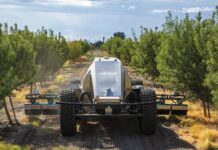
Scheid Family Wines in Monterey County uniquely shows how two generations of leaders in one family can successfully navigate the twists and turns of California’s wine industry over a span of 51 years yet innovate and grow the business, even in trying times. The winery’s success is the result of its nimble and agile approach as it explores different paths to profit.
Its newest wine brand, Sunny with a Chance of Flowers, shot to Hot Brand status in 2021, rivaling the performance of millennial and Gen Z favorite Josh wine. The winery also launched its first TV commercial to support Sunny’s launch.

In 2023, Wine Business ranked Scheid as the 25th largest winery in the U.S. It has 3,000+ acres of vineyards in Monterey County with annual sales of 900,000 cases. 60% of its business is in private labels (it makes 45 of them today for major retailers) and 40% of its business is in its 10 branded wines. It supplies 90% of the grapes for all the wines, buying 10%, including Paso Robles Cabernet (for a client who wanted Paso on a label).
The winery makes 100,000 cases a year of its new greatest hit, Sunny with a Chance of Flowers, in the Better for You (BFY) category, one which grew in dollar sales 13.3% (NIQ scan data from March 24, 2023-24) compared to non-BFY wines, which declined 1.5% in the same period. Unit sales were up 14.2% for BFY wine while non-BFY wines declined 4.3% in unit sales.
That new brand was an early entrant in the BFY space, thanks to Heidi Scheid perusing the grocery aisle for up-and-coming trends. It was there she also noticed consumers and products that said “no sugar” were gaining ground.
In 1972, business-savvy executive Al Scheid, a graduate of Harvard Business School, started the company as a tax loss venture, initially buying 10 acres of vines.
The company grew and grew as grape growers and then bulk winemakers selling to major brands. Today, it has 12 estate vineyards over a 70-mile stretch of the Salinas Valley.
In 2005, Scheid built its own winery, making private label wines, and in 2012 launched its own brands.

Financial prowess is baked into the heritage. Two of Al’s children, Heidi Scheid and Scott Scheid, each got degrees in finance and outside experience in the finance industry before joining the family business as Executive Vice President and President, respectively.
Scheid’s entry into finished wines has been fairly spectacular, growing from 4,000 to 700,000 cases in less than 10 years. The producer aims to get to a million cases by 2025.
In 2020, Wine Enthusiast honored Heidi with its Winestar award for Person of the Year.
Today, the company’s original and most expensive brand, Scheid Vineyards, features wines ranging in price from $28 to $90, fueled by direct-to-consumer sales. It has two tasting rooms: one in the popular wine tourist town of Carmel and the other in Greenfield in Salinas Valley. It’s arcing into the future with next-generation wine brands focused on younger and health-conscious consumers.
Targeting Gen Z and Millenials with Better for You, Low-Alcohol or Organic Brands
Scheid’s finished wine brands are on a roll, chasing younger and more health-conscious consumers with BFY, low-alcohol bottled wines as well as canned, fruit-flavored, low-alcohol spritzers and organically grown wines. All three are gluten free and vegan.
Introduced in 2020, Sunny with a Chance of Flowers ($17 to $20) is a big hit in the marketplace, growing from 11,000 to 100,000 cases now with the support of major retailers.
Sunny’s slogan, “Moderation has never tasted so good!”, messages its major appeal: 9% alcohol, 85 calories per serving and zero sugar.
Made with natural extracts and botanicals, Hoxie is similarly positioned with 5% alcohol, 90 calories and no added sugar. Hoxie first became popular in hipster circles in Los Angeles as brand creator and founder Josh Rosenstein, a former chef, concocted staff drinks with wine, fruit and herbs.
The grapes (Chardonnay, Pinot Noir, Petite Sirah and Sauvignon blanc) are all grown by Scheid. The three canned, flavored wines include Strawberry Rosé and Lemon Ginger Rosé along with Grapefruit Elderflower, its most popular. Wine Enthusiast gave Hoxie a 91-point score.
Since it has partnered with Scheid, Hoxie sells in BevMo, Sprouts, Target, Whole Foods and independent wine shops. Rosenstein is now Scheid’s Director of Alternative Beverages.
“I think alternative packaging in cans is also important,” Heidi said. “I think canned products are really suited to lower alcohol, and something that has some spritz, not still wine.”
Expanding its spritz niche, Scheid also partnered with Q Mixers to complement its Sunny wines, offering consumers more spritz flavor options. Sunny’s website leverages the cocktail craze with recipes that mix in everything from watermelon slices or ginger beer to alcoholic add-ins. Examples include elderflower-based St. Germain liqueur with Pinot Noir for a “Red Blossom” or tequila for a wine-based “Sunny-rita.”

Birth of a New Brand with Positivity: Sunny with a Chance of Flowers
Speaking in March at the Wine Market Council’s annual meeting, Scheid told the audience how she zeroed in on the BFY category and the importance of zero sugar before launching her Sunny with a Chance of Flowers brand.
“Why did White Claw become so popular so quickly?” she asked. “I think a lot of it is labeling. It has 5% alcohol right there at the top of the label. It says 100 calories at the top. It has ‘gluten free.’”
She said the wine producers could learn from that.
“We in the wine industry are not really known for good labeling in terms of giving consumers information. There are a lot of zero-sugar wines out there. Consumers don’t know which ones they are. And they have to kind of figure that out, by trial and error, whether it tastes sweet to them or not. So, we took a look at White Claw and just thought, ‘Okay, there’s something there that they’re doing that we’re not doing.’”
At the same time, she said, “We were seeing all these news articles about low [or] no-alcohol trends and lifestyles. We really started to ask ourselves, ‘Where does wine fit into this lifestyle conversation?’”
She set out to create a brand with low alcohol and high transparency.
“If making wine is hard, making a low-alcohol wine is harder, and making a low-alcohol, zero-sugar wine that tastes really great is super-duper hard,” she said. Scheid uses a reverse osmosis process to curb the alcohol levels. She wondered if ‘zero sugar’ really had to be in the mix.
“Taking a lesson from other product categories convinced us sugar is a very important attribute to consumers, and they want to know what the level of sugar is,” she said.
Sustainability has also proved to be a market differentiator, she said. Scheid is certified sustainable by the Wine Institute’s CSWA program, won the California Green Medal Environment Award in 2019 and has been 100% powered by wind for seven years.
Scheid credits brand developer Theresa Scripps for the Sunny brand name and packaging.
“In terms of lifestyle attributes, we really wanted to project positivity. We wanted it to lean into moderation. When we were originally launching Sunny, there was pushback from people saying, ‘Wine is already the drink of moderation. Why do we need a healthier version of wine?’”
Heidi responded, “Because we can do better. I can lean into that more for people who really are interested in pursuing moderation and who are interested in consumption.”
Pivoting to Organics–Grandeur
Transparency and going after a distinct market segment are also high on the priority list with Scheid’s organically grown Grandeur brand, produced solely from the company’s 667 acres of certified organic grapes.
After originally announcing it would convert all 3,000+ acres to organic, Scheid dialed back its organic expansion plans, responding both to the market and its initial organic conversion efforts which found that vines in its coolest, coastal and northern areas (regions I, II and III, according to the Winkler index) struggled with mildew.
“It’s really kind of just pushing ourselves as growers to see what’s possible in our region,” Heidi said.
The vineyard team found greater success with its warmer, southerly vineyards in Hames Valley (classified Region IV in the Winkler index) focusing initially on Petite Sirah. Cabernet Franc, Malbec and Petit Verdot soon followed. The Region IV organic vines are close to the San Luis Obispo County border with Paso Robles.
“We cut our teeth on organic farming on the 90-acre White Flower Vineyard,” she said. “We were able to start it off as organic rather than doing the conversion, which is a little more complex. We found we can be pretty successful down there.”
Scheid said the winery has plenty of grapes for its organic program, selling Grandeur at Whole Foods, Natural Grocers and Total Wine. “The organic market is still pretty nascent,” she said. “Going organic–that’s a big ship to turn. It’ll be interesting to see how that space unfolds over the next few years.”
But organics’ appeal to younger consumers is compelling, she said.
According to Bonterra, sales of organically farmed wines grew 7% in 2023 in a year when overall wine sales declined. Scheid’s Aristotle brand, a $12.99 Whole Foods exclusive from Scheid’s organically grown Petite Sirah, outperformed peers in a year when the brand changed from sustainable to organic and redesigned its label. Aristotle’s depletions were up 7% in 2022 over the previous year, while similarly priced Petite Sirah wines were down 24%, a Scheid spokesperson said.
In addition, Scheid’s organically grown wines have ingredient labeling. “I think younger people care very much about how their products they consume are made and what’s in them,” Heidi said. “They want a level of transparency. Grandeur has ingredient labeling on the back. I don’t see that happening very much across the industry.”
Into the Future: Engagement and Portfolio Diversity Are Key to Success
Scheid looks at the evolving wine landscape as an opportunity to broaden the offerings. Wellness is one way to build engagement. Organics is another. And transparency is another option.
“A brand has to deliver the right price for that particular consumer to meet them where they are,” she said.
Though the winery has 10 brands of its own, Scheid said Sunny is the No. 1 priority. “It’s our largest brand and very much has the support of our retailers who are seeing great success within that ‘Better for You’ category,” she said.
“Building brand loyalty is a different game these days. It’s tougher. I think Sunny with a Chance of Flowers wins because it has this really positive brand ethos. Many people are drawn to that. We definitely have extremely loyal consumers of Sunny, which is great to see. We hear from them a lot, through social media and DMs. People are really engaged.
“There’s always going to be that consumer that wants the bigger, bolder wine,” she continued. “We certainly have that in our portfolio. And there are people that buy at different price points. But the younger consumer who we’re trying to on-ramp into wine has so many choices in front of them, a really astounding number of choices just when they walk into a store. And then if they get onto their phones, which they’re typically on quite a bit, there’s just a whole world out there. So how do we create something that excites them?”
Younger drinkers are much more focused on drinking according to the occasion, she said. And that calls for variety.
“I will always love the classically made wines. I think that’s where people will end up or will at least have as part of their repertoire. They might drink Sunny with a Chance of Flowers where that really fits what they’re trying to do on a Tuesday night and then Hoxie by the pool on a Saturday or down at the beach. And then hopefully, they’ll drink a beautiful, classically made Chardonnay or Pinot Noir or a Cabernet on Friday and Saturday night. There’s room for all of it. And I think that’s what consumers want these days is that choice of having a wine that suits the occasion.”
That variety of wine can maintain wine’s universal appeal, she said.
“That applies to people whether they’re young moms, or middle aged, or like my mom who’s 86 who had given up drinking. Sunny pulled her back into the wine world. She has her little glass of Sunny Sauvignon Blanc at 5 p.m. every day, and then a glass of Sunny Pinot Noir with dinner at night. They’re the littlest pours you’ve ever seen. But she loves having this 9% option available.”
Heidi’s mom was a wine drinker her entire life, and is extremely healthy, but stopped drinking for two years because her doctor said he didn’t know if she should be drinking wine at her age.
“She was really sad that she had to give up wine,” said Scheid.
“When we first bottled it, I dropped off some Sunny bottles for her, and she called me that night, and was literally crying, saying, ‘You have allowed me to reclaim a piece of my life that I had to give up. Because you don’t understand what it’s like to be in your 80s, nobody gives you anything to add to your life. They only take away things like you’re not supposed to do. So finally, I get to have something come back into my life.’”











